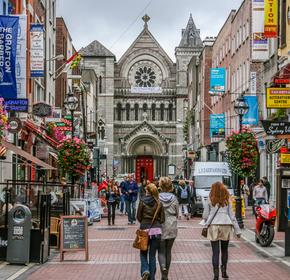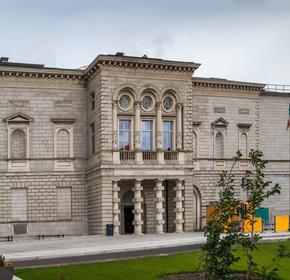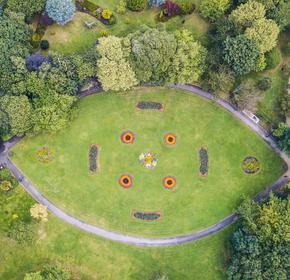
Dublin travel guide
Dublin Tourism | Dublin Guide
You're Going to Love Dublin
Ireland’s capital city is known for its friendly atmosphere and superb scenery and attractions. The birthplace of Oscar Wilde and the home of Guinness, Dublin has something to offer everyone.
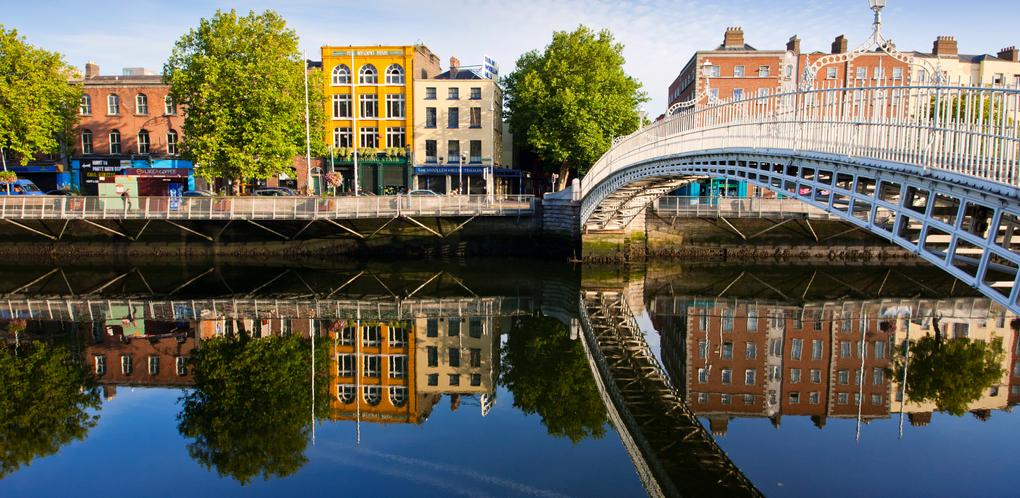
Dublin lies on the east coast of Ireland at the mouth of the River Liffey. Cross the river on any of its beautiful bridges to enjoy unique views of landmarks like Trinity College or the Customs House, or explore unspoiled beaches just a short distance from the city center.
Over a third of the population of Ireland call Dublin home. It’s the biggest city in the country and its outstanding colleges and universities attract students from all over the world. The city’s young-at-heart character and friendly locals make it the ideal choice for long vacations or short city breaks.
World-class shopping, dining, and entertainment in and around Grafton Street are just part of the city’s charm. Join in the "craic" at one of the city’s friendly bars and pubs or explore its history and culture in exceptional museums and galleries.
Top 5 Reasons to Visit Dublin
1. Go for the "Craic"
You’ll get a warm welcome wherever you go, and you’ll soon be joining in with the "craic" in bars and restaurants like a local. The "craic" simply means friendly banter, news, gossip, and conversation. Expect to be greeted by that famous line, "What’s the craic?", meaning, "What’s happening with you?" or simply, "How are you?" but be warned, Dubliners have a wicked sense of humor.
2. It’s a Literary Center
Dublin is famous for its connections to some of the world’s most important writers and poets. James Joyce set his landmark novel, Ulysses, in the city and some of the heavyweights who have called Dublin home include Oscar Wilde, Samuel Beckett, and Jonathon Swift. Take the famous Dublin Literary Pub Crawl, visit the Dublin Writers Museum in Parnell Square, or nod to the statue of Oscar Wilde in Merrion Square Park.
3. Try a Drop of the Black Stuff
No visit to Dublin is complete unless you sample the city’s most famous drink. Visit the Guinness Storehouse at St. James’ Gate for a tour that culminates in a taste of the famous brew in the Gravity Bar. Guinness is also served in every bar, pub, licensed restaurant, and hotel in the city.
4. A Magical Riverside Setting
Dublin is a fairly compact city on the banks of the River Liffey. The river can be crossed via a number of spectacular bridges including the Ha’Penny Bridge, the O’Connell Bridge, and the Samuel Beckett Bridge. Take a river cruise or wander among the trendy bars and restaurants of the renovated docklands and quayside.
5. Castles, Monuments, and Parks
17th-century Phoenix Park is one of the city’s most appealing spaces. As well as wide open grassland dotted with grazing fallow deer, you’ll find a perfectly proportioned Victorian garden and landmarks like Ashdown Castle and the Wellington Monument – Europe’s largest obelisk. The park is also home to Dublin Zoo
What to do in Dublin
1. Trinity College: An Academic (or Magical?) Experience
If you've ever wondered what it would feel like to have gone to school at Hogwarts, a trip to Trinity College is the perfect introduction. As soon as you set foot on campus you feel like you've stepped back into a different world with many historic stone houses, intricate wood work, sprawling gardens, and impressive libraries. Trinity College is one of the oldest Universities in the world, inaugurated by Queen Elizabeth herself in 1592. It remains one of the most highly respected educational institutions and landmarks in the whole of Ireland.
2. Grafton Street: Shop 'till You Drop
Time to hit the shops and start buying some souvenirs for the trip home! Grafton Street is a completely pedestrianized shopping zone that was designed to help visitors relax and prolong their time walking between the street's many shops. Here you can find international brands like Swatch, Tommy Hilfiger, and Top Shop right alongside local community stops like Bewley's Oriental Cafe, which hosts regular concerts in its performance space. Many musicians have also busked on Grafton Street and used that success to launch their music careers including Glen Hansard, Damien Rice and Paddy Casey.
3. St. Stephen's Green: Take a Breath of Fresh Air
St Stephen's Green has done the same for Dublin as Central Park has for New York -- opened up a breath of fresh air and greenery right in the middle of the city center. The 22-acre park point is located right next to Grafton Street in the center of downtown, and it often attracts visitors who spill out into the green following their afternoon shopping. Relax with a book by the large lake or grab a friend and enjoy an afternoon of people watching around the south side's open heath. James Joyce and W.B Yeats also have memorials here commemorating their contributions to Irish heritage through poetry and literature.
4. National Gallery of Ireland: Immerse yourself in Art
Avoid Ireland's notorious rain and spend the afternoon strolling through works of Irish and European art at the National Gallery of Ireland. The newly refurbished museum on Merrion Square features artwork from the 14th to the 20th century including famous pieces by Raeburn, Maclise and Monet. Those with artistic ambitions will enjoy the pop-up art talk series, which gives in-depth analyses about specific paintings within their historical context. Authors, Dancers and Painters are also regularly invited for speaker series in which visitors can get to know the person and better understand the process behind some of their favorite creations.
5. Guinness Storehouse: Get yourself a 'real' Guinness
Fancy yourself a pint? Look no further than Dublin's own Guinness Brewery, specializing in the famous dark stout. Guinness has been practicing the art of brewing beer for almost 250 years and that mastery truly shows inside Storehouse headquarters. The guided tour will take you through some of the brand's variations over the years, allowing you to sample some of the different beers on tap. At the end of your tour, consider getting a pint and relaxing at the rooftop "Gravity Bar", which offers some spectacular views of Dublin city center.
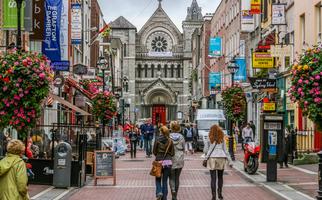
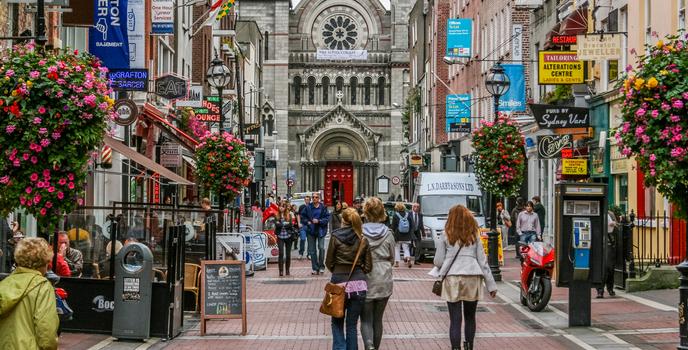
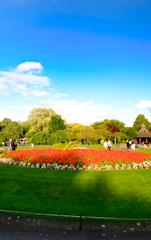
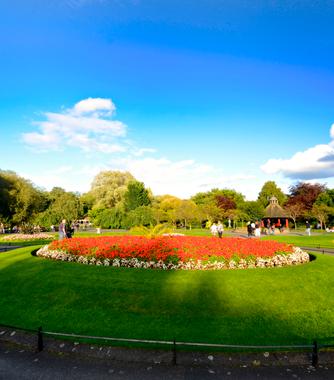

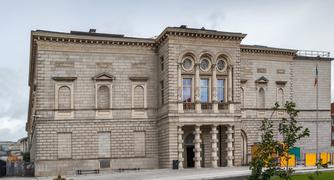
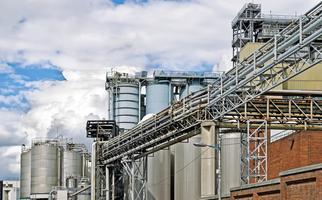
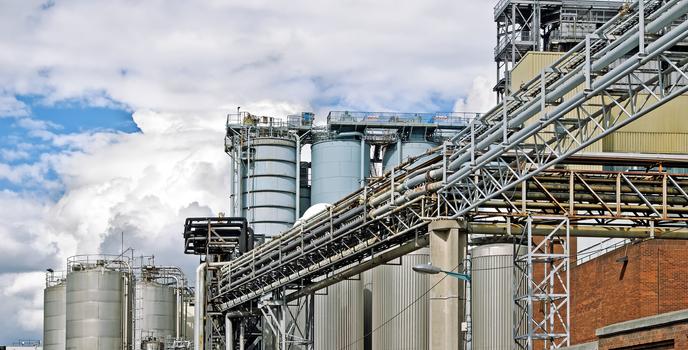
1. Trinity College: An Academic (or Magical?) Experience
If you've ever wondered what it would feel like to have gone to school at Hogwarts, a trip to Trinity College is the perfect introduction. As soon as you set foot on campus you feel like you've stepped back into a different world with many historic stone houses, intricate wood work, sprawling gardens, and impressive libraries. Trinity College is one of the oldest Universities in the world, inaugurated by Queen Elizabeth herself in 1592. It remains one of the most highly respected educational institutions and landmarks in the whole of Ireland.
2. Grafton Street: Shop 'till You Drop
Time to hit the shops and start buying some souvenirs for the trip home! Grafton Street is a completely pedestrianized shopping zone that was designed to help visitors relax and prolong their time walking between the street's many shops. Here you can find international brands like Swatch, Tommy Hilfiger, and Top Shop right alongside local community stops like Bewley's Oriental Cafe, which hosts regular concerts in its performance space. Many musicians have also busked on Grafton Street and used that success to launch their music careers including Glen Hansard, Damien Rice and Paddy Casey.
3. St. Stephen's Green: Take a Breath of Fresh Air
St Stephen's Green has done the same for Dublin as Central Park has for New York -- opened up a breath of fresh air and greenery right in the middle of the city center. The 22-acre park point is located right next to Grafton Street in the center of downtown, and it often attracts visitors who spill out into the green following their afternoon shopping. Relax with a book by the large lake or grab a friend and enjoy an afternoon of people watching around the south side's open heath. James Joyce and W.B Yeats also have memorials here commemorating their contributions to Irish heritage through poetry and literature.
4. National Gallery of Ireland: Immerse yourself in Art
Avoid Ireland's notorious rain and spend the afternoon strolling through works of Irish and European art at the National Gallery of Ireland. The newly refurbished museum on Merrion Square features artwork from the 14th to the 20th century including famous pieces by Raeburn, Maclise and Monet. Those with artistic ambitions will enjoy the pop-up art talk series, which gives in-depth analyses about specific paintings within their historical context. Authors, Dancers and Painters are also regularly invited for speaker series in which visitors can get to know the person and better understand the process behind some of their favorite creations.
5. Guinness Storehouse: Get yourself a 'real' Guinness
Fancy yourself a pint? Look no further than Dublin's own Guinness Brewery, specializing in the famous dark stout. Guinness has been practicing the art of brewing beer for almost 250 years and that mastery truly shows inside Storehouse headquarters. The guided tour will take you through some of the brand's variations over the years, allowing you to sample some of the different beers on tap. At the end of your tour, consider getting a pint and relaxing at the rooftop "Gravity Bar", which offers some spectacular views of Dublin city center.








Where to Eat in Dublin
Dublin has lots of terrific restaurants and you can try everything from classic European food to Indian curries and traditional fish and chips. City Centre restaurants tend to be more expensive but there are lots of affordable cafes and small independent restaurants in Temple Bar and in the redeveloped docklands area.
Indian cuisine is extremely popular and some of the best restaurants can be found around South William Street. The street is parallel to Grafton Street and a three-course meal deal for early birds in the Khyber Tandoori on South William Street or Shalimar on South Great Georges Street costs about 15 euros. Vegetarians may enjoy the cheap but tasty Hare-Krishna food served at Govindas on Augnier Street or Surma on Camden Street. Fans of Chinese and Asian cuisine should make their way to Parnell Street while those who prefer more traditional fare can tuck into fish and chips at Leo Burdock Fish & Chips in Werburgh Street.
When to visit Dublin
Dublin has a maritime climate with fairly cool summers and mild winters. July and August temperatures of 66°F to 72°F and winter temperatures of 39°F to 46°F mean that it’s always pleasant. The peak tourist season is between May and September and the city is particularly busy from mid-July to mid-August - the traditional annual holiday period for Ireland and the UK. Major attractions can be busy during the summer season and hotel prices reflect the increased demand for accommodation. However, Dublin is a great choice at any time and breaks in Spring, from March to April, or Autumn, from September until late October, mean that you’ll benefit from less crowded streets and beautiful seasonal scenery. Or, why not visit for Christmas and New Year? There are events for all ages throughout the city and you may see Bono and Glen Hansard who often join Christmas Eve buskers on Grafton Street. Adventurous types can even work up an appetite by taking part in the Forty Foot Dip in the sea at Sandycove on Christmas Day.
How to Get to Dublin
Plane
Many overseas visitors arrive at Dublin Airport (IATA: DUB) which is 6 miles north of the city center. The airport is a hub for Irish national carrier, Aer Lingus and for the country’s second largest airline, Ryanair. Other airlines which fly to and from Dublin include Flybe, British Airways, and Air France. Several shuttle buses run from the airport to central Dublin including Aircoach (Route 700) and the Dublin Bus airport service (route 747). Taxis are available and it is also possible to rent a car close to the airport.
Train
Dublin is served by two main rail stations. Heuston Station, to the west of the city centre, is the terminus for trains from cities in the south and west of Ireland including Limerick and Cork. Those traveling from Belfast or Sligo or other cities in the north or east will alight at Connolly Station which is to the north-east of the city center. Local buses stop nearby, and both stations are served by the city’s light rail tram system, LUAS. Passengers arriving at Connolly Station can take taxis from the taxi rank close to the station entrance.
Car
Drivers coming to Dublin from Belfast can take the A1 then the M1 and continue their journey on local road R131 and then the R801 and R105. The journey from Northern Ireland to Dublin includes an international border crossing and part of the trip may be by toll road. Those driving from Limerick can take the M7, while the M8 and M7 are ideal if you’re coming from Cork. US visitors who arrive in the country at Shannon Airport (IATA: SNN) can also take the M7 via Limerick.
Bus
Buses to Dublin run from several European countries thanks to carriers like National Express and Megabus. You’ll also find buses from major Irish cities run by local operators like Dublin Bus, while travelers from Belfast to Dublin can take Translink’s Goldline service. All Dublin bound buses terminate at the Busarus coach station in the city center. The station is adjacent to Connolly Station and local buses, trams and taxis can ferry you to any part of the city.
Airports near Dublin
Airlines serving Dublin
Where to stay in Dublin
City Centre - generally agreed to be the area within about 1.5 miles of the O’Connell Bridge. This vibrant district is home to most of the city’s most famous historical and cultural attractions. You’ll also find glamorous nightlife and entertainment and the Grafton Street area is known for its abundance of friendly cafes and great shops.
Popular Neighborhoods in Dublin
Temple Bar – home to the world-famous bar of the same name, the Temple Bar area is widely known as the city’s "Cultural Quarter". Its quaint cobbled streets are a marked contrast to the wide streets of the city center and you’ll enjoy wandering through the clothing and jewellery stalls in Cows Lane before stopping for a break at one of the many restaurants and pubs.
Georgian Quarter – an elegant area in the southeast of Dublin around Merrion Square, Baggot Street, and Fitzwilliam Square. See the statue of Oscar Wilde and the beautiful 18th-century townhouses or simply enjoy the wide, grassy spaces, and laid back atmosphere of this stylish part of the city.
Where to stay in popular areas of Dublin
Most booked hotels in Dublin
How to Get Around Dublin
Public Transportation
Dublin has a good local bus service run by Dublin Bus as well as its LUAS light rail tram system. The DART commuter rail line also covers the city center. All buses, trams, and local trains use a pre-paid card system. The refundable Leap Card can be obtained from all main stations, newsagents, and tourist information offices. It can be topped up as required and there is a flat maximum fare of 2.60 euros on bus and tram journeys.
Taxi
Thanks to deregulation in 2001, Dublin now has more taxis than New York. That means that you can almost always find a taxi and that fairs are relatively cheap with an average city center trip costing from 6 to 10 euros.
Car
Although traffic can be heavy at peak times, a car can prove an asset on any trip to Dublin. Remember to drive on the left and you will have no problem navigating the city streets. Car rental is available close to the airport and at several locations in the city. There is a pay and display parking system in the center of the city with a maximum stay of 3 hours. Car parking facilities can also be found close to main tourist spots.
The Cost of Living in Dublin
Dublin's Hottest Shopping Streets
Grafton Street is one of the city’s best-known shopping areas - it’s also pedestrianized so you can browse clothes, electronics, jewelry, and homeware at your leisure. From Grafton Street, it’s just a short walk to the Powerscourt Centre where you’ll find everything from clothes and accessories to galleries and cafes in a beautiful 18th century townhouse setting. On the north side of the Liffey, O’Connell Street is home to all the top brands and designers while adjacent Henry Street is the busiest shopping street in Ireland.
Groceries and Other Necessities
Food and basic goods are relatively expensive in Ireland. However, with a choice of supermarket chains like Tesco, Super Valu, Dunnes Stores, and Superquinn to choose from you’re sure of finding all that you need for your holiday rental easily.
